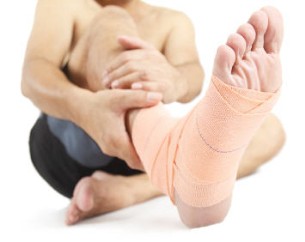The unstable ankle - Sports Medicine Doctor Malta - Dr Danica Bonello Spiteri
Main menu:
The unstable ankle
The unstable ankle (First published on vida magazine on May 2013)
Now that summer is literally upon us, we start to enjoy outdoor activities even more. However, a problematic ankle may hinder our enjoyment, so now is a good time to tame it.
Have you ever twisted an ankle which results in some nasty swelling and possible bruising? Do you regularly go over or twist your ankle during daily activities? Unfortunately this is a common problem to both young and old, yet can be improved considerably.
The ankle is a joint that involves the shin bones (tibia and fibula) and foot bones, (talus). The ankle moves in various directions, but requires stability at the same time. Ligaments aid stability of the ankle, and they are located both on the inside (medial) and outer side (lateral) of the ankle joint. The most common way to twist an ankle is to twist it inwards (inversion injury). This is just due to the way the ankle bones, mainly the longer fibula, are built, which prevents the ankle from twisting outwards (eversion injury).
The ligaments on the outer (lateral) side of the ankle are the ones commonly injured in the form of a sprain, and occasionally these may be totally torn, which causes increased ankle instability.
The ligaments are also important in balance and maintaining our ankle in a stable position. This is called proprioception. When rehabilitating an injured ankle, it is important to work on stretching and strengthening the muscles around the ankle joint, but proprioception must not be overlooked.
One simple test to see if proprioception is deficient is to try stand on one foot. Some people may find that this is already hard to do and wobble around alot. A further step is to try stand on one foot and close your eyes. When attempting to test this, please do have somewhere to hold on to, because if proprioception is poor, you may fall and hurt yourself!
This wobbling around when closing your eyes occurs since we balance our body by what we see through our eyes, and what we feel in our feet. If we remove the visual input, by closing our eyes, and the balance in our feet is poor, it will result in a wobble or possibly a fall.
This is the reason why some people constantly twist their ankle, as when the ankle starts to twist, it is usually able to correct itself through good balance. If however, proprioception is poor, once the ankle starts to twist, it is unable to correct itself and continues to twist inwards (invert) even more.
Remedies for this include practising standing on one leg with different variations such as:
increasing amount of time spent standing with closed eyes
standing on a wobble board/unstable surface
rocking forward/backward on foot to create an unstable surface
rotating head to right and left

For direct contact or to book a consultation please send an email on:
drdanica@sportsmedicinemalta.com